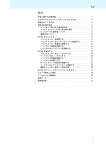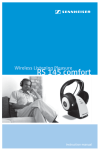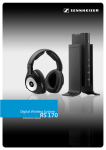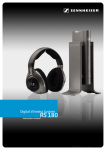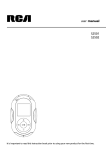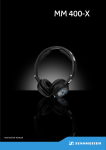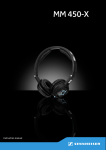Download Sennheiser HDC 450 Instruction manual
Transcript
Digital Wireless System RS 160 Instruction manual Contents Contents Important safety information ........................................................................... 2 The RS 160 digital RF headphone system ...................................................... 4 Delivery includes .................................................................................................. 5 Product overview ................................................................................................. 6 Overview of the HDR 160 headphones ..................................................... 6 Overview of the TR 160 transmitter .......................................................... 7 Overview of the indicators and acoustic signals ..................................... 8 Overview of the connection stages .......................................................... 10 Putting the RS 160 into operation ................................................................. 11 Setting up the transmitter ......................................................................... 11 Connecting the transmitter to a sound source ...................................... 12 Powering the transmitter .......................................................................... 13 Powering the headphones ......................................................................... 15 Adjusting the headband of the headphones ......................................... 17 Using the RS 160 ............................................................................................... 18 Switching the transmitter on and off ...................................................... 18 Switching the headphones on and off .................................................... 20 Adjusting the volume on the headphones ............................................. 21 Adjusting the signal of the sound source ............................................... 22 Associating the headphones to the transmitter ................................... 23 Listening with several headphones simultaneously ............................ 26 Cleaning the RS 160 .......................................................................................... 27 If a problem occurs ... ........................................................................................ 28 Accessories and spare part .............................................................................. 30 Specifications ...................................................................................................... 31 Manufacturer declarations ............................................................................... 32 1 Important safety information Important safety information • Please read this instruction manual carefully and completely before using the product. • Make this instruction manual easily accessible to all users at all times. Always include this instruction manual when passing the product on to third parties. • Do not use the product in situations which require special attention (e.g. in traffic or when performing skilled jobs). • Always keep the product dry and do not expose it to extreme temperatures (normal operating temperatures: 0 °C/32 °F to 40 °C/ 104 °F). • Use the product with care and store it in a clean, dust-free environment. • Switch the headphones off after use to conserve battery power. Remove the batteries if the product will not be used for extended periods of time. • The headphones contain magnets that generate a magnetic field which could cause interference with cardiac pacemakers and implanted defibrillators. Keep the headphones at least 1.2” (3 cm) from cardiac pacemakers or implanted defibrillators. • Please protect your hearing from high volume levels. Sennheiser headphones also sound exceptionally good at low volumes. • Only use the Sennheiser supplied power supply units. • To reduce the risk of fire or electric shock, do not use the product near water and do not expose it to rain or moisture. • Unplug the power supply unit from the wall socket – to completely disconnect the product from the mains – during lightning storms or – when unused for long periods of time. • Only operate the power supply unit from the type of power source specified in the chapter “Specifications” (see page 31). • Ensure that the power supply unit is – in a safe operating condition and easily accessible, – properly plugged into the wall socket, – only operated within the permissible temperature range, – not covered or exposed to direct sunlight for longer periods of time in order to prevent heat accumulation (see “Specifications” on page 31). 2 • Do not operate the product near any heat sources. • Only use attachments/accessories specified by Sennheiser (see “Accessories and spare part” on page 30). Important safety information Replacement parts When replacement parts are required, be sure the service technician uses replacement parts specified by Sennheiser or those having the same characteristics as the original part. Unauthorized substitutions may result in fire, electric shock, or other hazards. Intended use Intended use of the product includes • having read this instruction manual, especially the chapter “Important safety instructions” on page 2, • using the product within the operating conditions and limitations described in this instruction manual. “Improper use” means using the product other than as described in this instruction manual, or under operating conditions which differ from those described herein. Safety instructions for the NiMH rechargeable batteries If abused or misused, the rechargeable batteries may leak. In extreme cases, they may even present • • • • a heat hazard, a fire hazard, an explosion hazard, a smoke or gas hazard. Please understand that Sennheiser does not accept liability for damage arising from abuse or misuse. Keep away from children. Only use rechargeable batteries recommended by Sennheiser. Observe correct polarity. Do not short-circuit. Do not expose to moisture. Switch rechargeable batterypowered products off after use. Do not pack charged batteries loose – danger of shorting out/fire hazard. When not using rechargeable batteries for extended periods of time, charge them regularly (about every 3 months). Only charge rechargeable batteries at ambient temperatures between 10 °C/50 °F and 40 °C/ 104 °F. Do not heat above 70 °C/ 158 °F, e.g. do not expose to sunlight or throw into a fire. Do not mutilate or dismantle. Do not continue to use defective rechargeable batteries. Immediately remove rechargeable batteries from obviously defective devices. Dispose of rechargeable batteries at special collection points or return it to your specialist dealer. 3 The RS 160 digital RF headphone system The RS 160 digital RF headphone system The RS 160 is an RF stereo hi-fi headphone system with comprehensive technical features. Its transparent and balanced sound image with excellent bass response makes this system an ideal choice for hi-fi, home cinema and TV use. Enjoy total freedom of sound, stylish design and maximum comfort. Additional features of the RS 160 headphone system • Transmits uncompressed audio over a robust 2.4 GHz digital link, enabling you to enjoy your music without the hassles of cables. • Dynamic transducer systems with powerful neodymium magnets deliver clear and detailed audio reproduction. • Kleer’s uncompressed digital wireless transmission delivers CD-quality sound. • No set-up required – just plug and play. Simply connect the transmitter to your personal audio/video player, put on the headphones and turn it on! • TR 160 transmitter with multi-receiver capability, enabling up to 4 people to listen to the same sound source. KleerTM wireless transmission technology The RS 160 headphone system features the digital wireless audio transmission technology from Kleer. The Kleer company has developed an RF-based wireless transmission standard (of the same name) that offers lossless audio transmission in CD-quality while consuming minimal power. 4 Delivery includes Delivery includes 1 HDR 160 headphones 1 TR 160 transmitter 1 power supply unit with country adapters 1 stereo audio cable with 3.5 mm jack plugs 1 DC cable (4.0 mm DC jack socket to 2 x 4.0 mm DC plug) 2 AAA size NiMH rechargeable batteries, 1.2 V 1 quick guide incl. CD ROM with detailed instruction manual (PDF file) 1 safety guide 5 Product overview Product overview Overview of the HDR 160 headphones 쐃 쐇 HDR 160 쐊 쐏 쐄 쐂 쐆 쐋 쐋 쐃 Headband 쐏 VOLUME + button 쐇 Ear pads 쐄 Multi-function button 쐋 Battery compartments 쐂 VOLUME – button 쐆 Charging socket (DC 5V 0.5A) 쐊 Multi-function LED With the multi-function button 쐄, you can switch the headphones on/to standby mode, set the headphones to multi-user operation, mute the headphones and associate the headphones. 6 Product overview Overview of the TR 160 transmitter 1 2 3 4 5 햲 Multi-function button 햳 Multi-function LED 햴 Socket for power supply unit (DC 5V 0.5A) 햵 Audio input (AUDIO IN) 햶 VOLUME control (– +) With the multi-function button 햲, you can switch the transmitter on/to standby mode, set the transmitter to multi-user operation and associate the transmitter. 7 Product overview Overview of the indicators and acoustic signals Meaning of the pictograms for the different LEDs Status Meaning The LED is lit. The LED flashes once per second. 1s The LED flashes twice every 5 seconds. 5s Indicators on the headphones Indicator Status Multi-function LED 쐊 1s Meaning The rechargeable batteries are almost flat. The rechargeable batteries are being charged. off 1s 1s 5s 8 The rechargeable batteries are fully charged. The headphones are in enrollment mode (searching for a transmitter to pair with). The headphones are in association mode (exchanging device information with the transmitter). The headphones receive an audio signal. Product overview Indicators on the transmitter Indicator Status Multi-function LED 햳 Meaning The signal of the sound source is too strong. 1s 1s 5s 5s The transmitter is in enrollment mode (searching for headphones to pair with). The transmitter is in association mode (exchanging device information with the headphones). The transmitter is in singleuser operation. The transmitter is in multiuser operation. Acoustic signal of the headphones 1 short beep Meaning The minimum volume is reached. The maximum volume is reached. 9 Product overview Overview of the connection stages Connection establishment Enrollment mode When you switch the headphones and the transmitter on, the headphones search for a suitable transmitter. 1s Pairing HDR 160 The headphones and the transmitter have recognized each other and the headphones are paired with the transmitter. 5s HDR 160 Single-user and multi-user operation Single-user operation You can listen to your sound source via one pair of headphones. By default, the transmitter is set to single-user operation (see page 23). 5s Multi-user operation HDR 160 In order to be able to listen to your sound source with several headphones simultaneously, you have to set your transmitter to multi-user operation (see page 26). 5s HDR 160 HDR 160 HDR 160 10 Putting the RS 160 into operation Putting the RS 160 into operation Setting up the transmitter 왘 Choose a suitable place near your sound source (e.g. TV, stereo or home cinema system). Music Photos Videos Extras Settings Shuffle Songs 왘 Do not place the transmitter close to metal objects such as shelf bars, reinforced concrete walls, etc. as this can decrease the transmitter’s range. 왘 Make sure that there is direct line of sight between the transmitter and the headphones. 11 Putting the RS 160 into operation Connecting the transmitter to a sound source You can connect the TR 160 transmitter to different sound sources, such as a TV, a DVD player or a stereo system. 왘 Switch your sound source off before connecting the transmitter. 4 6 왘 Connect the audio cable 햷 to the audio input 햵 of the transmitter. 왘 Connect the audio cable 햷 to the headphone socket of your sound source. 6 왘 Adjust the volume on your sound source to a medium level. This improves the quality of wireless sound transmission. If necessary, check the settings of your sound source. 12 Putting the RS 160 into operation Powering the transmitter For powering the TR 160 transmitter, you can use: • the supplied SSA-4P 5050F power supply unit for stationary use • rechargeable batteries (AA size, NiMH, 1.2 V, at least 1,300 mAh) for mobile use • standard batteries (AA size, 1.5 V) for mobile use Powering the transmitter via the power supply unit 왘 Select the suitable country adapter 햹 for your wall socket. 왘 Slide the country adapter 햹 onto the power supply unit 햸 until it locks into place. 8 EU UK US AU 7 왘 Connect the connector 햺 of the power supply unit to the socket 햴. 3 2 9 왘 Plug the power supply unit 햸 into a wall socket. The transmitter switches on. The multi-function LED 햳 flashes green after 9 seconds. The transmitter is in enrollment mode. 1s You can also connect the charging cable 햻 to the connector 햺 of the power supply unit to conveniently charge your headphones (see “Charging rechargeable batteries in the headphones” on page 16 ). 0 13 Putting the RS 160 into operation Inserting rechargeable batteries/standard batteries into the transmitter and changing them 왘 Power the TR 160 transmitter either with rechargeable batteries (AA size, NiMH, 1.2 Vat least 1,300 mAh) or standard batteries (AA size, 1.5 V). 왘 Open the battery compartment at the base of the transmitter as shown. 왘 Remove the depleted rechargeable batteries or batteries (where applies). 왘 Insert the rechargeable batteries or batteries. Observe correct polarity. 1s 14 왘 Close the battery compartment. The cover locks into place with an audible click and the transmitter switches on. The multi-function LED 햳 flashes green after 9 seconds. The transmitter is in enrollment mode. Putting the RS 160 into operation Powering the headphones For powering the headphones, you can use: • standard batteries (AAA size, 1.5 V) • rechargeable batteries (AAA size, NiMH, 1.2 V, 600 mAh) If you use rechargable batteries, you can charge them in the headphones using the charging cable 햻 (see next chapter). Inserting rechargeable batteries/standard batteries into the headphones and changing the rechargeable batteries/standard batteries 왘 Remove the ear pads 쐇 from both ear cups by turning the ear pads in the direction of the arrow until you overcome a slight resistance. 왘 Lift the ear pads 쐇 off the ear cups. 쐇 쐇 왘 Remove the depleted rechargeable batteries or batteries (where applies). 왘 Insert the rechargeable batteries or batteries. Observe correct polarity. 왘 Secure the ear pads 쐇 to the ear cups. 15 Putting the RS 160 into operation Charging rechargeable batteries in the headphones CAUTION Danger of damage to the headphones! If standard batteries are inserted into the headphones, the batteries can leak during charging and damage the headphones. 왘 Only charge rechargeable batteries in your headphones. 16h Charge the rechargeable batteries for at least 16 hours prior to first time use. Subsequent charging time is about half of the previous operating time. The operating time is up to 24 hours. 왘 Connect the charging cable 햻 to the charging socket 쐆 on the headphones. 왘 Connect the charging cable 햻 to the socket 햴 on the transmitter. 왘 Connect the charging cable 햻 to the connector 햺 of the power supply unit. 왘 Plug the power supply unit 햸 into a wall socket. The rechargeable batteries are being charged. The multi-function LED 쐊 on the headphones lights up orange. 7 쐊 쐆 9 0 3 The transmitter automatically switches from battery operation to mains operation if you connect the power supply unit or the charging cable 햻 to the transmitter. 16 Putting the RS 160 into operation Adjusting the headband of the headphones For good sound quality and best possible comfort, the headband has to be adjusted to properly fit your head. To do so, adjust the headband 쐃 via its snap-in locking mechanism: 쐃 HDR 160 왘 Wear the headphones so that the headband 쐃 runs over the top of your head. 왘 Adjust the length of the headband so that – your ears are completely inside the earpads, – you feel even, gentle pressure around your ears, – a snug fit of the headband 쐃 on the head is ensured. 17 Using the RS 160 Using the RS 160 To switch the product on and to listen to your sound source, proceed as follows: Sequence of steps Page 1. Make sure that the rechargeable batteries are charged. 16 2. Switch your sound source on. – 3. Switch your transmitter on. 18 4. Switch your headphones on. 20 5. Adjust the desired volume. 21 Switching the transmitter on and off Switching the transmitter on 1s 5s 왘 Press the multi-function button 햲 for approx. 1 second. The transmitter switches on. The multi-function LED 햳 flashes green, indicating that the transmitter is in enrollment mode. Once the transmitter has found suitable headphones, it pairs with the headphones and transmits an audio signal. The multi-function LED 쐊 of the headphones and the multi-function LED 햳 of the transmitter flash slowly. 쐊 1 2 18 Using the RS 160 Switching the transmitter off 왘 Press the multi-function button 햲 for approx. 1 second. The multi-function LED 햳 goes off. The transmitter is in standby mode. To disconnect the transmitter from the mains: 왘 Pull out the mains plug from the wall socket. If the headphones are outside the transmission range or switched off for more than 5 minutes, the transmitter automatically switches to standby mode. The multi-function LED 햳 goes off. In standby mode, the transmitter’s power consumption is very low so that it can remain connected to the mains. 19 Using the RS 160 Switching the headphones on and off WARNING Danger due to high volumes! Listening at high volume levels for long periods can lead to permanent hearing defects. 왘 Before putting the headphones on, set the volume to a low level. 왘 Do not continuously expose yourself to high volumes. Switching the headphones on 1s 5s 왘 Press the multi-function button 쐄 for approx. 1 second. The headphones switch on. The multi-function LED 쐊 flashes green, indicating that the headphones are in enrollment mode. Once the headphones have found a suitable transmitter, the transmitter pairs with the headphones and transmits an audio signal. The multi-function LED 쐊 of the headphones and the multi-function LED 햳 of the transmitter flash slowly. 쐄 쐊 2 Switching the headphones off 왘 Press the multi-function button 쐄 for approx. 1 second. The multi-function LED 쐊 goes off. The headphones are in standby mode. If there is no signal from the transmitter for more than 5 minutes, the headphones automatically switch to standby mode. 20 Using the RS 160 Adjusting the volume on the headphones 왘 Press the VOLUME – button 쐂 or the VOLUME + button 쐏 repeatedly until the volume is adjusted to a comfortable and undistorted level. 쐂 쐏 Vol - Vol + Vol - Vol + Muting the headphones 왘 Briefly press the multi-function button or to cancel the muting. 쐄 to mute the headphones 쐄 21 Using the RS 160 Adjusting the signal of the sound source The transmitter automatically ensures that the headphones always receive an optimum signal. If necessary, use the VOLUME control 햶 to adjust the volume of the audio signal. However, the signal of the sound source can be so strong that it can no longer be automatically adjusted. If the signal of the sound source is too strong, the multi-function LED 햳 of the transmitter flashes or lights up red. 왘 Either adjust the VOLUME control 햶 on the transmitter so that the multi-function LED 햳 stops flashing or lighting up red. 왘 Or adjust the volume of your sound source so that the multi-function LED 햳 stops flashing or lighting up red. 5 22 2 Using the RS 160 Associating the headphones to the transmitter The RS 160 system features the digital wireless audio transmission technology from Kleer. You can also associate other Kleer compatible headphones (e.g. the Sennheiser MX W1) to the transmitter. For more information, refer to the chapter “Associating other Kleer compatible headphones to the transmitter” on page 25 or to the instruction manual of the corresponding product. The headphones and the transmitter are already associated upon delivery. You only have to associate the headphones to the transmitter • if you want to use another pair of Kleer compatible headphones or • if the transmission between the headphones and the transmitter is disturbed by interferences in the vicinity. If you want to use several headphones, refer to the chapter “Associating several headphones to the transmitter” on page 25. Associating the HDR 160 headphones to the transmitter When associating the headphones to the transmitter, the distance between the transmitter and the headphones should not exceed 1 m. 왘 Make sure that the transmitter and the headphones are in standby mode (see page 19 and 20). 23 Using the RS 160 1s 왘 Simultaneously press the multi-function button 햲 of the transmitter and the multi-function button 쐄 of the headphones for 7 seconds. The multi-function LED 햳 of the transmitter flashes green. 7s 1 2 쐄 5s After approx. 30 seconds, the headphones are paired with the transmitter and you can hear your sound source via the headphones. The multifunction LED 쐊 of the headphones and the multi-function LED 햳 of the transmitter flash green. 1 쐄 24 쐊 2 Using the RS 160 Associating other Kleer compatible headphones to the transmitter The following describes how to associate the Sennheiser MX W1 earphones to the TR 160 transmitter. For information on how to associate other Kleer compatible headphones to the transmitter, refer to the instruction manual of the corresponding product. 왘 Press the operation/pairing button on both MX W1 earphones for 7 seconds. 왘 Press the multi-function button 햲 of the transmitter for 7 seconds. 7s 1 2 5s After approx. 30 seconds, the MX W1 earphones are paired with the transmitter and you can hear your sound source via the earphones. The multi-function LED 햳 of the transmitter flashes green. Associating several headphones to the transmitter In order to be able to use several headphones simultaneously, you first have to associate your additional headphones to the transmitter. Follow the steps in the previous chapter “Associating the headphones to the transmitter” on page 23. You can then only use the last headphones paired to listen to your sound source (single-user operation). To listen to your sound source with up to 4 headphones simultaneously: 왘 Set your transmitter to multi-user operation as described in the next chapter. 25 Using the RS 160 Listening with several headphones simultaneously By default, the transmitter is set to single-user operation. In order to be able to listen to your sound source with several headphones simultaneously, you have to set your transmitter to multi-user operation. 왘 Make sure that all headphones are paired to the transmitter (see previous chapter). 왘 Switch all headphones on (see page 20). 왘 Then switch the transmitter on (see page 18). 5s 왘 Briefly press the multi-function button 햲 of the transmitter. The multi-function LED 햳 of the transmitter and the multi-function LEDs 쐊 of the headphones flash green. You can now listen to your sound source with several headphones simultaneously. HDR 160 HDR 160 HDR 160 When pressing the transmitter’s multi-function button 햲 in multi-user operation, the transmitter switches to single-user operation. You can still listen to your sound source with the last headphones paired, the other headphones are disconnected from the transmitter. 26 Cleaning the RS 160 Cleaning the RS 160 CAUTION Liquids can damage the electronics of the product! Liquids entering the housing of the product can cause a short-circuit and damage the electronics. 왘 Keep all liquids far away from the product. 왘 Do not use any cleansing agents or solvents. 왘 Before cleaning, switch the product off and disconnect the transmitter from the mains. 왘 Only use a dry and soft cloth to clean the product. Replacing the ear pads For reasons of hygiene, you should replace the earpads from time to time. Spare earpads are available from your Sennheiser dealer (see “Accessoires and spare parts” on page 30). 왘 Remove the ear pads 쐇 from the ear cups by turning the ear pads in the direction of the arrow until you overcome a slight resistance. 왘 Lift the ear pads 쐇 off the ear cups. 쐇 쐇 왘 Secure the new ear pads to the ear cups. 27 If a problem occurs ... If a problem occurs ... Sound problems Problem Possible cause No sound Transmitter is/headphones Switch the are switched off transmitter/ headphones on Occasional sound dropouts Page 18/20 Headphones are muted Cancel the muting 12 Jack plug is not properly connected Check the plug connection 12 Sound source is switched off Switch the sound source on – Audio cable is defective Replace the cable – Transmission between transmitter and headphones is disturbed by interferences (including ESD) in the vicinity Associate the headphones with the transmitter again 23 Disconnect the transmitter from the mains and reconnect it again 13 Remove the rechargeable batteries and reinsert them again 15 Headphones are not correctly associated with the transmitter (e.g. additional headphones) Associate the headphones with the transmitter 23 Headphones are out of range Reduce the distance between headphones and transmitter 12 Signal is shielded Remove obstacles between transmitter and headphones 12 Interfering devices in the vicinity Change your position 12 Increase the volume of the sound source – Signal of the sound source is too weak Turn the VOLUME control 햶 on the transmitter clockwise 21 Headphone volume is adjusted too low Increase the volume by pressing the VOLUME + button 쐏 21 Sound is too Volume of the sound low source is adjusted too low 28 Possible solutions If a problem occurs ... Problem Possible cause Possible solutions Sound only on one ear Audio cable is defective Replace the audio cable Sound is distorted Multifunction LED 햳 on the transmitter flashes or lights up red Page – Audio cable is not properly Check the plug connected connection 12 Signal of the sound source is distorted Reduce the volume of the sound source – Reduce the volume by pressing the VOLUME – button 쐂 on the headphones 21 Turn the VOLUME control 햶 on the transmitter counter-clockwise 22 Reduce the volume of the sound source 22 Signal of the sound source is too strong Other problems Problem Possible cause The No mains connection transmitter cannot be switched on Possible solution Check the connection of the power supply unit to the transmitter and to the mains Headphone Rechargeable batteries are Recharge the s cannot be flat rechargeable switched on batteries Rechargeable batteries are Remove the inserted the wrong way rechargeable round batteries and reinsert them again. Observe correct polarity Operating time decreases Rechargeable batteries are Replace the exhausted rechargeable batteries Page 13 16 15 14/15 If a problem occurs that is not listed in the above table or if the problem cannot be solved with the proposed solutions, please contact your local Sennheiser partner for assistance. To find a Sennheiser partner in your country, search at www.sennheiser.com. 29 Accessories and spare part Accessories and spare part Only use original Sennheiser accessories and spare parts, otherwise the product quality can be impaired or the product can be damaged. 30 Cat. No. Accessory/spare part 504250 HDR 160 headphones 534480 Power supply unit with country adapters 534486 Stereo audio cable with two 3.5 mm jack plugs (2 m) 534479 DC cable (4.0 mm DC jack socket to 2 x 4.0 mm DC plug) 093778 Adapter (3.5 mm jack socket to ¼“ (6.3 mm) jack plug) 514267 Adapter (3.5 mm jack socket to 2 RCA plugs) 534470 1 pair of ear pads (closed type) Specifications Specifications RS 160 system Modulation MSK digital Carrier frequencies 2.4 – 2.48 GHz Range approx. 20 m in the open area Ambient temperature 32 °F to 104 °F (0 °C to 40 °C) TR 160 transmitter Audio connection 3.5 mm stereo jack socket Power consumption (standby mode) < 0.3 W Power supply 5 V , 500 mA 2 AA size batteries, 1.5 V or 2 AA size NiMH rechargeable batteries, 1.2 V, at least 1,300 mAh Transmission power < 2.5 mW Operating time with batteries approx. 120 hours Weight (w/o batteries) approx. 56 g Dimensions 8.7 cm x 9.7 cm x 2.7 cm HDR 160 headphones Transducer principle circumaural, closed Max. SPL 106 dB (SPL) THD < 0.5 % at 1 kHz, 100 dB SPL Frequency response 18 Hz – 21,000 Hz Charging time of rechargeable batteries approx. 16 hours Power supply 2 AAA size NiMH rechargeable batteries, 1.2 V, 600 mAh Operating time approx. 24 hours Weight approx. 226 g (w/o rechargeable batteries) SSA-4P 5050F power supply unit Rated input 100 – 240 V~, 0.2 A, 50 – 60 Hz Rated output 5 V , 500 mA Operating temperature range 32 °F to 104 °F (0 °C to 40 °C) 31 Manufacturer declarations Manufacturer declarations Warranty Sennheiser GmbH & Co. KG gives a warranty of 24 months on this product. For the current warranty conditions, please visit our website at www.sennheiser.com or contact your Sennheiser partner. In compliance with the following requirements • RoHS Directive (2002/95/EC) • WEEE Directive (2002/96/EC) • Battery Directive (2006/66/EC) CE Declaration of Conformity • R&TTE Directive (1999/5/EC) • EMC Directive (2004/108/EC) • Low Voltage Directive (2006/95/EC) The declaration is available at www.sennheiser.com. Before putting the product into operation, please observe the respective country-specific regulations! Rechargeable batteries The supplied rechargeable batteries can be recycled. Please dispose of them as special waste or return them to your specialist dealer. In order to protect the environment, only dispose of exhausted batteries. WEEE Declaration Your Sennheiser product was developed and manufactured with highquality materials and components which can be recycled and/or reused. This symbol indicates that electrical and electronic equipment must be disposed of separately from normal waste at the end of its operational lifetime. Please dispose of this product by taking it to your local collection point or recycling centre for such equipment. This will help to protect the environment in which we all live. 32 Manufacturer declarations Statements regarding FCC and Industry Canada FCC Declaration of Conformity (DoC) SENNHEISER Model No: RS 160 Sennheiser Electronic Corporation Strat. Marketing • Stefanie Reichert One Enterprise Drive • Old Lyme • CT 06371 • USA Tel: +1 (860) 434 9190, ext. 144 Fax: +1 (860) 434 1759 We, declare the above device comply with the requirements of Federal Communications Commission. This device complies with Part 15 of the FCC rules. Operation is subjected to the following two conditions: 1) This device may not cause harmful interference, and 2) This device must accept any interference received, including interference that may cause undesired operation. Responsible Party: John Falcone This device complies with Part 15 of the FCC Rules and with RSS-210 of Industry Canada. Operation is subject to the following two conditions: (1) this device may not cause harmful interference, and (2) this device must accept any interference received, including interference that may cause undesired operation. This equipment has been tested and found to comply with the limits for a Class B digital device, pursuant to Part 15 of the FCC Rules. These limits are designed to provide reasonable protection against harmful interference in a residential installation. This equipment generates, uses and can radiate radio frequency energy and, if not installed and used in accordance with the instructions, may cause harmful interference to radio communications. However, there is no guarantee that interference will not occur in a particular installation. If this equipment does cause harmful interference to radio or television reception, which can be determined by turning the equipment off and on, the user is encouraged to try to correct the interference by one or more of the following measures: • Reorient or relocate the receiving antenna. • Increase the separation between the equipment and receiver. • Connect the equipment into an outlet on a circuit different from that to which the receiver is connected. • Consult the dealer or an experienced radio/TV technician for help. This class B digital apparatus complies with the Canadian ICES-003. Changes or modifications made to this equipment not expressly approved by Sennheiser electronic Corp. may void the FCC authorization to operate this equipment. RF Radiation Exposure Information Since the radiated output power of this device is far below the FCC radio frequency exposure limits, it is not subjected to routine RF exposure evaluation as per Section 2.1093 of the FCC rules. 33 Manufacturer declarations In compliance with: USA FCC ID: DMOTR160 FCC ID: DMOHDR160 Canada IC: 2099A-TR160 IC: 2099A-HDR160 Europe Australia/ New Zealand Singapore Trademarks The Kleer logo is a trademark of Kleer Inc. About ENERGY STAR ENERGY STAR is a joint program of the U.S. Environmental Protection Agency and the U.S. Department of Energy helping us all save money and protect the environment. 34 Sennheiser electronic GmbH & Co. KG Am Labor 1, 30900 Wedemark, Germany www.sennheiser.com Publ. 08/09 A01





































